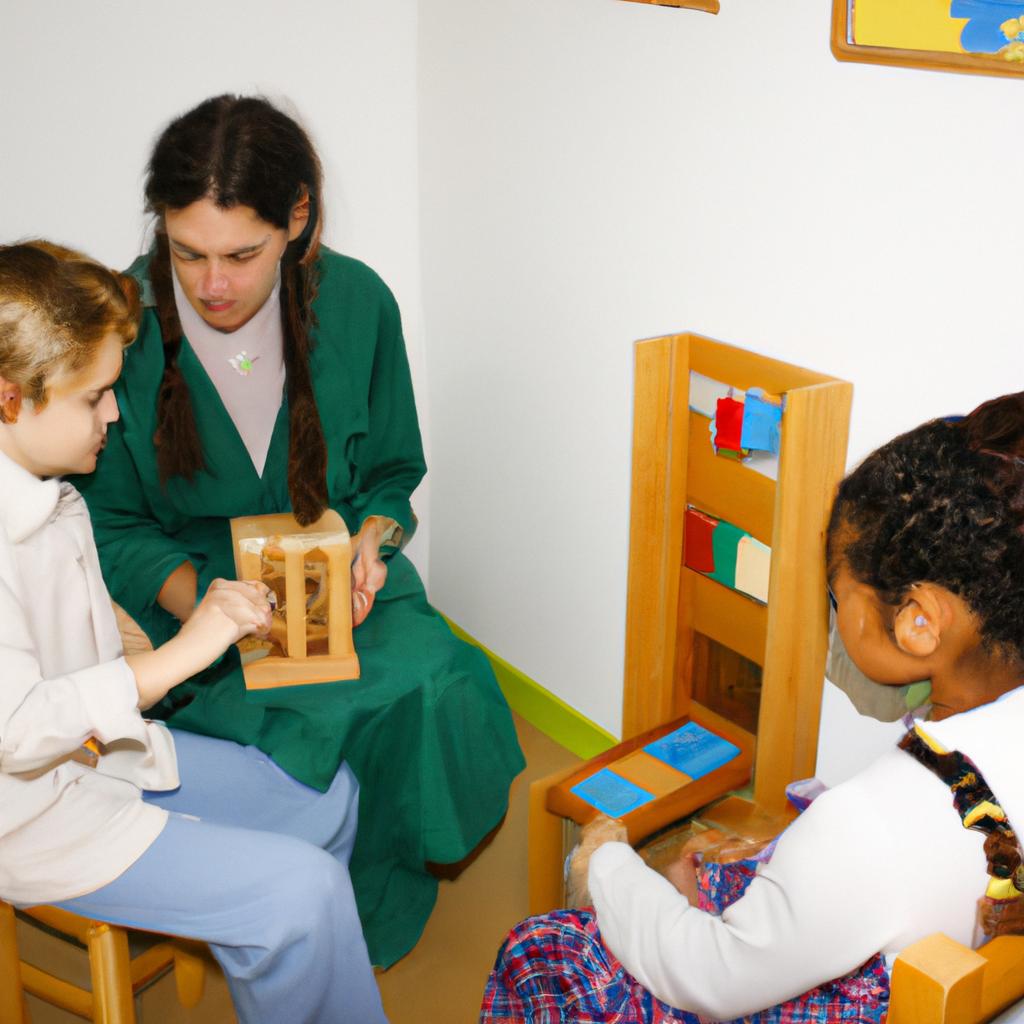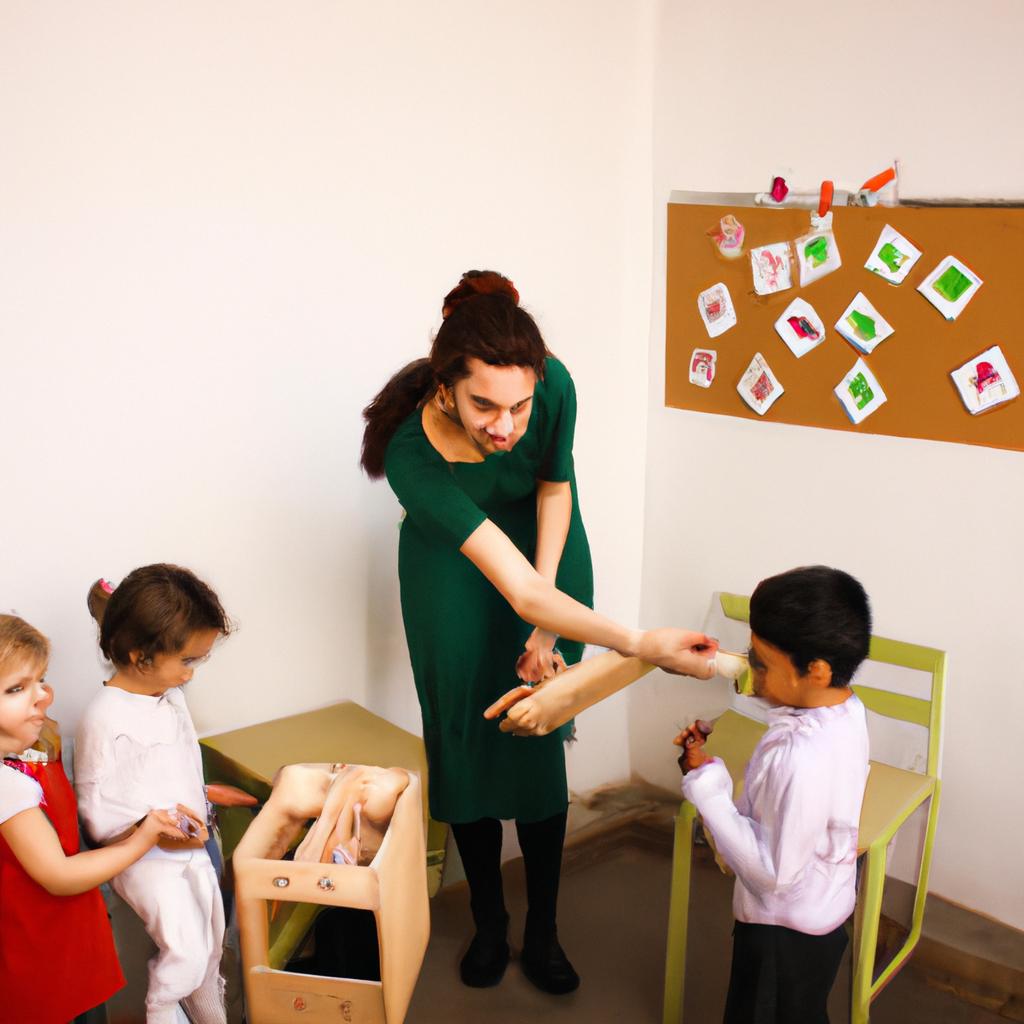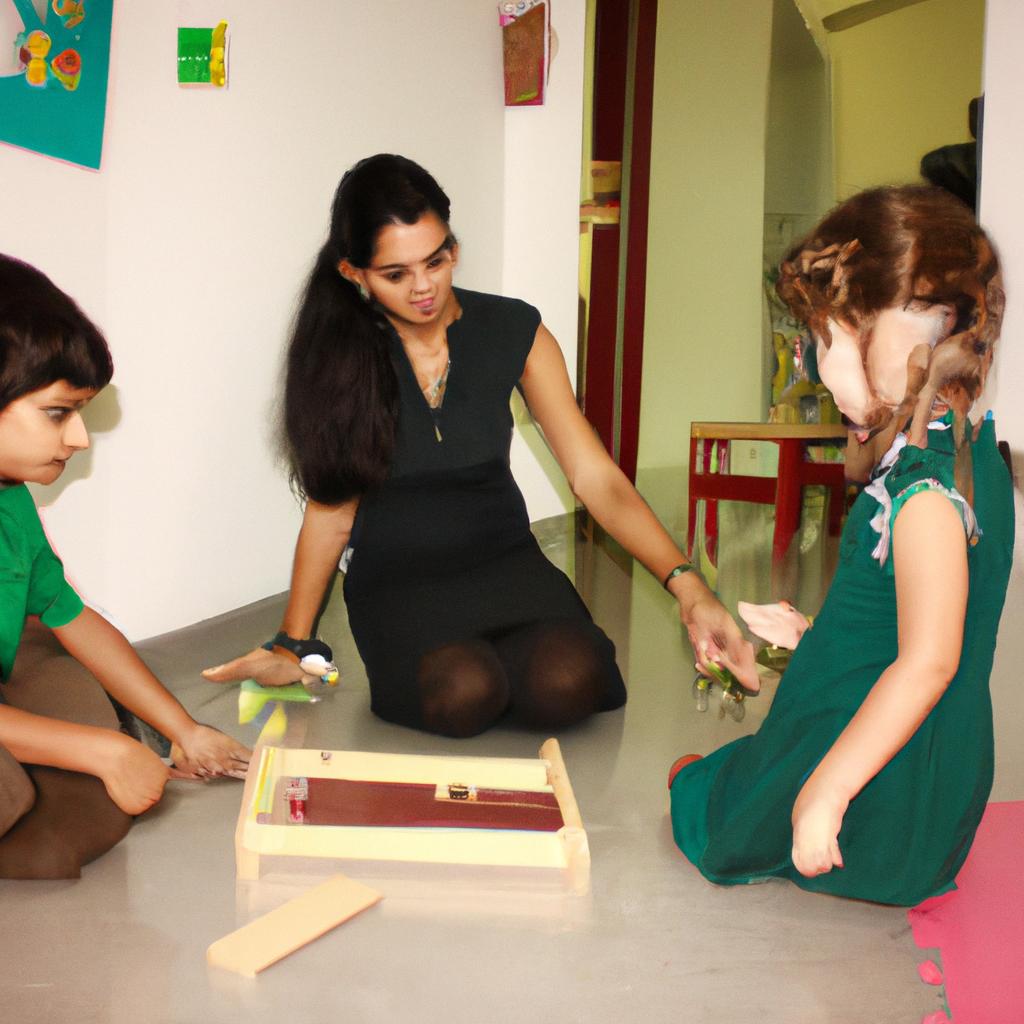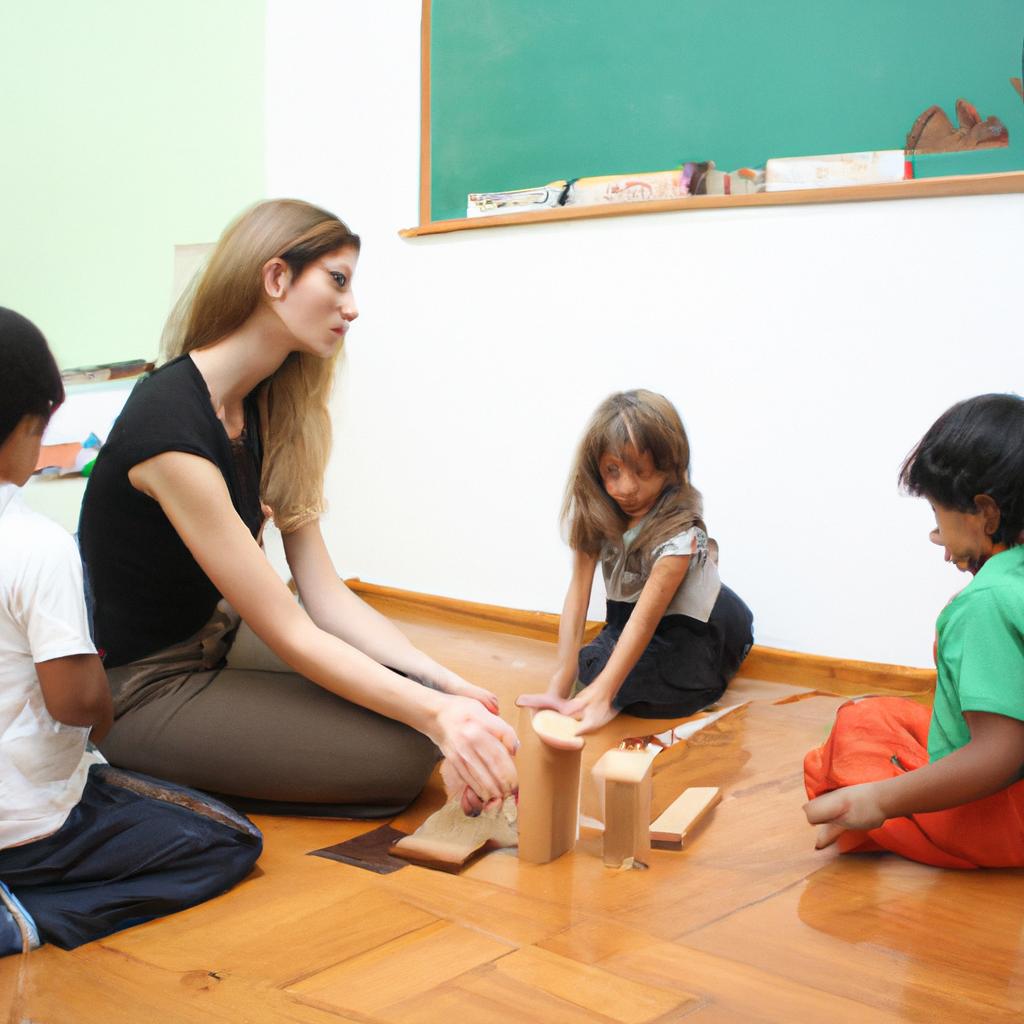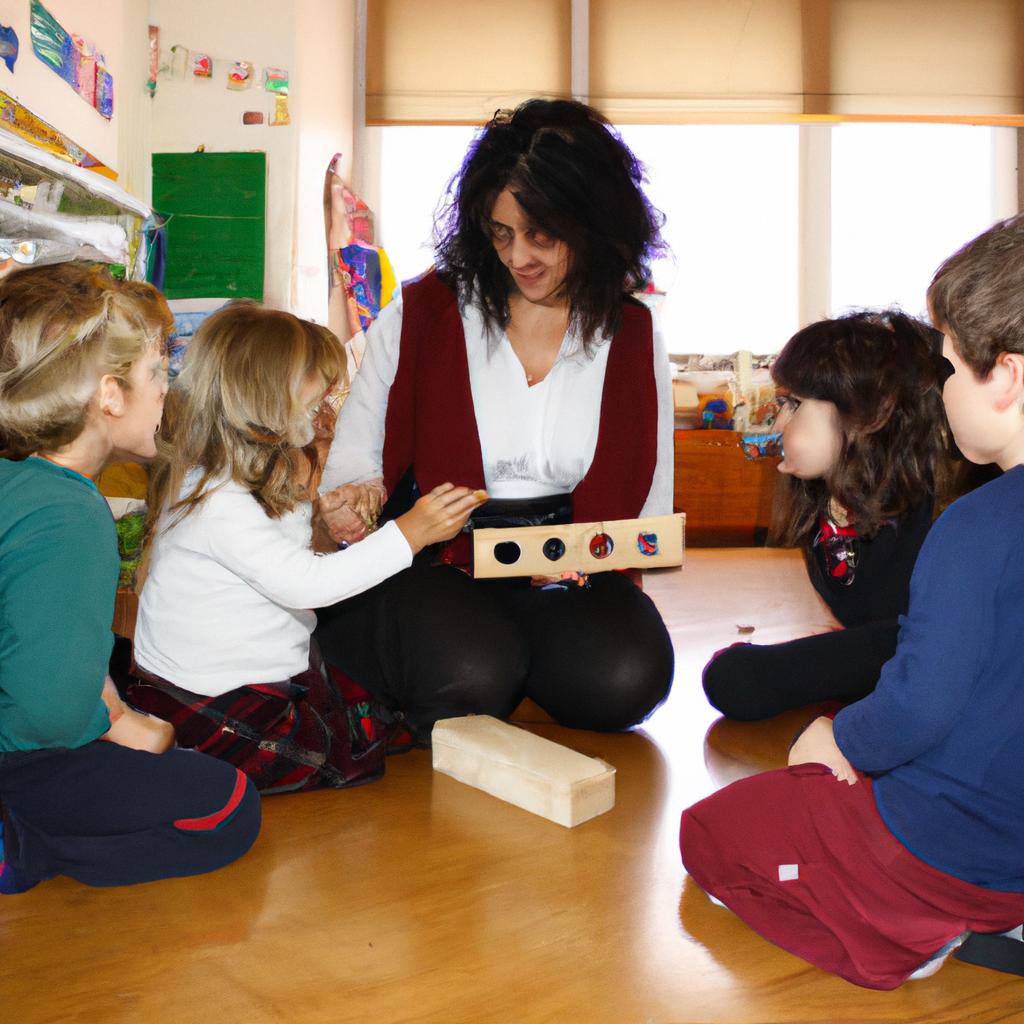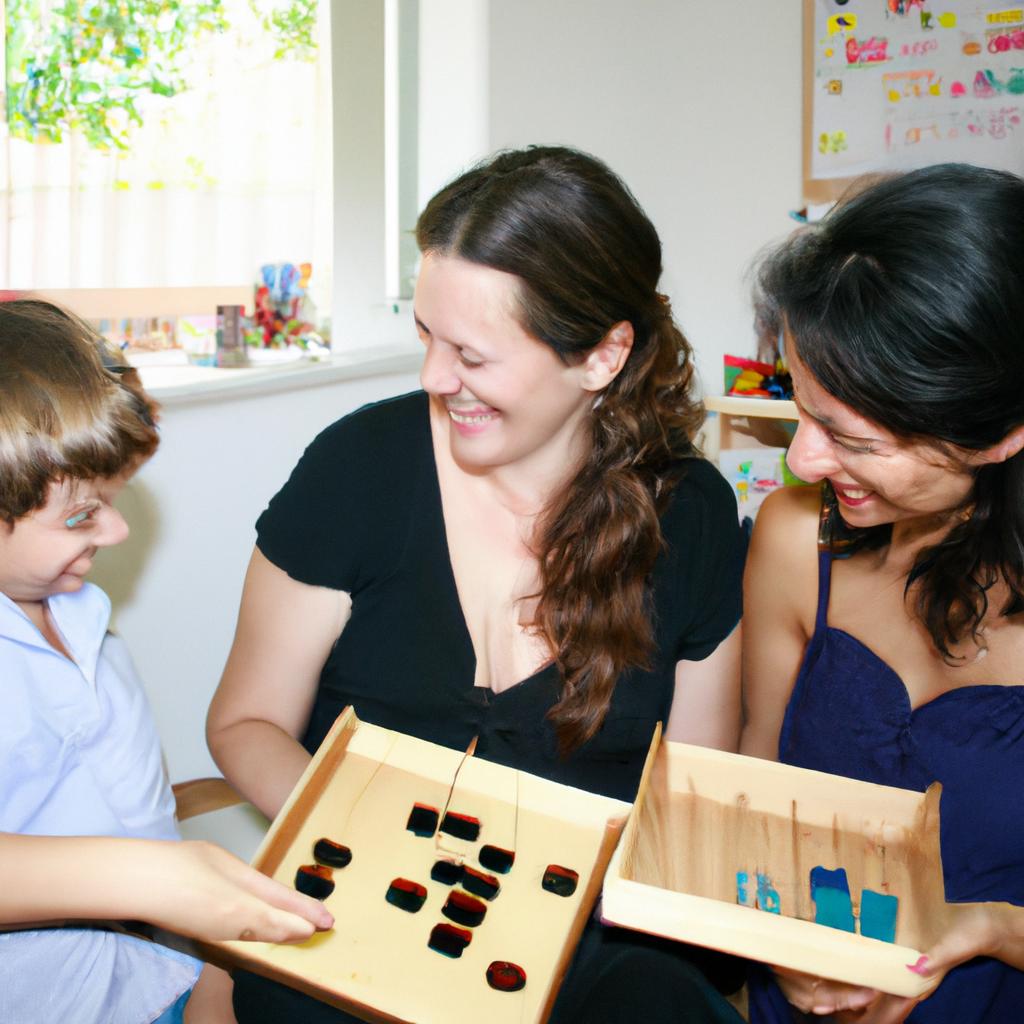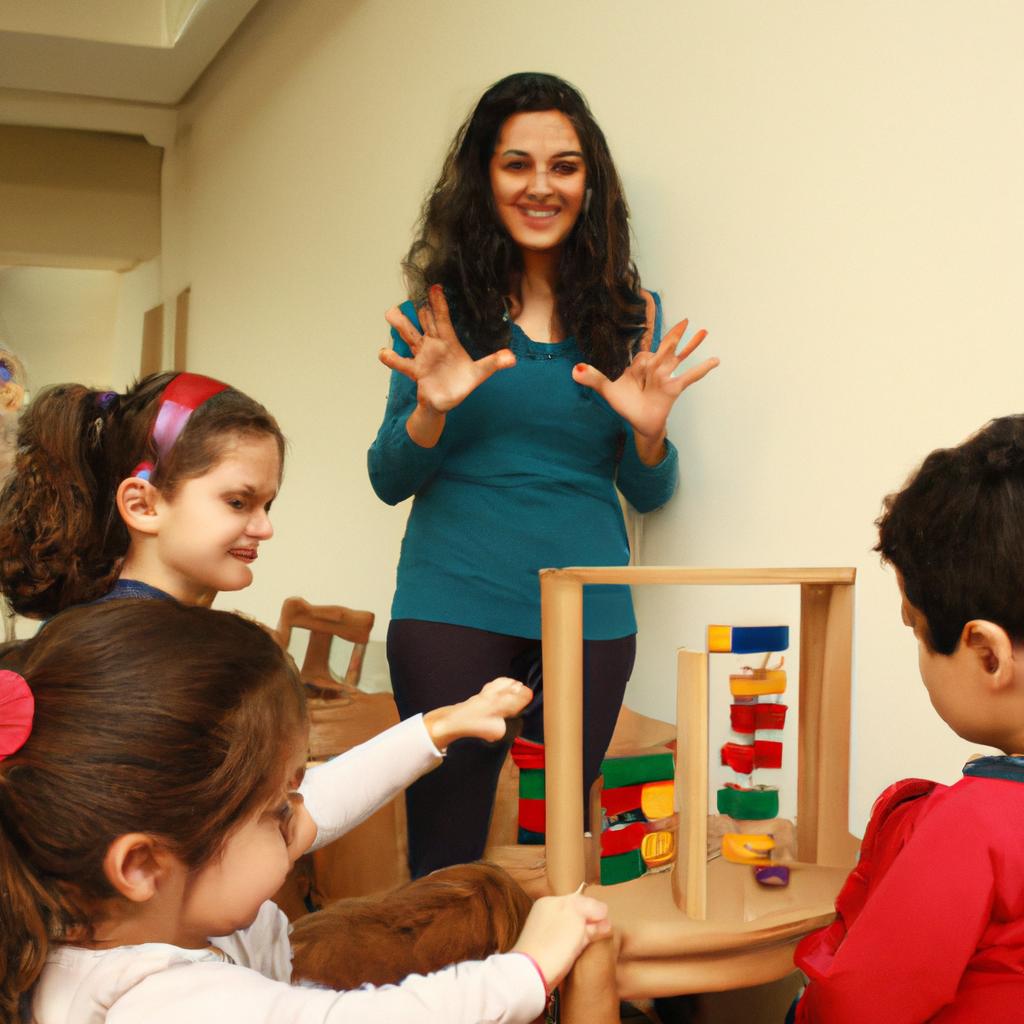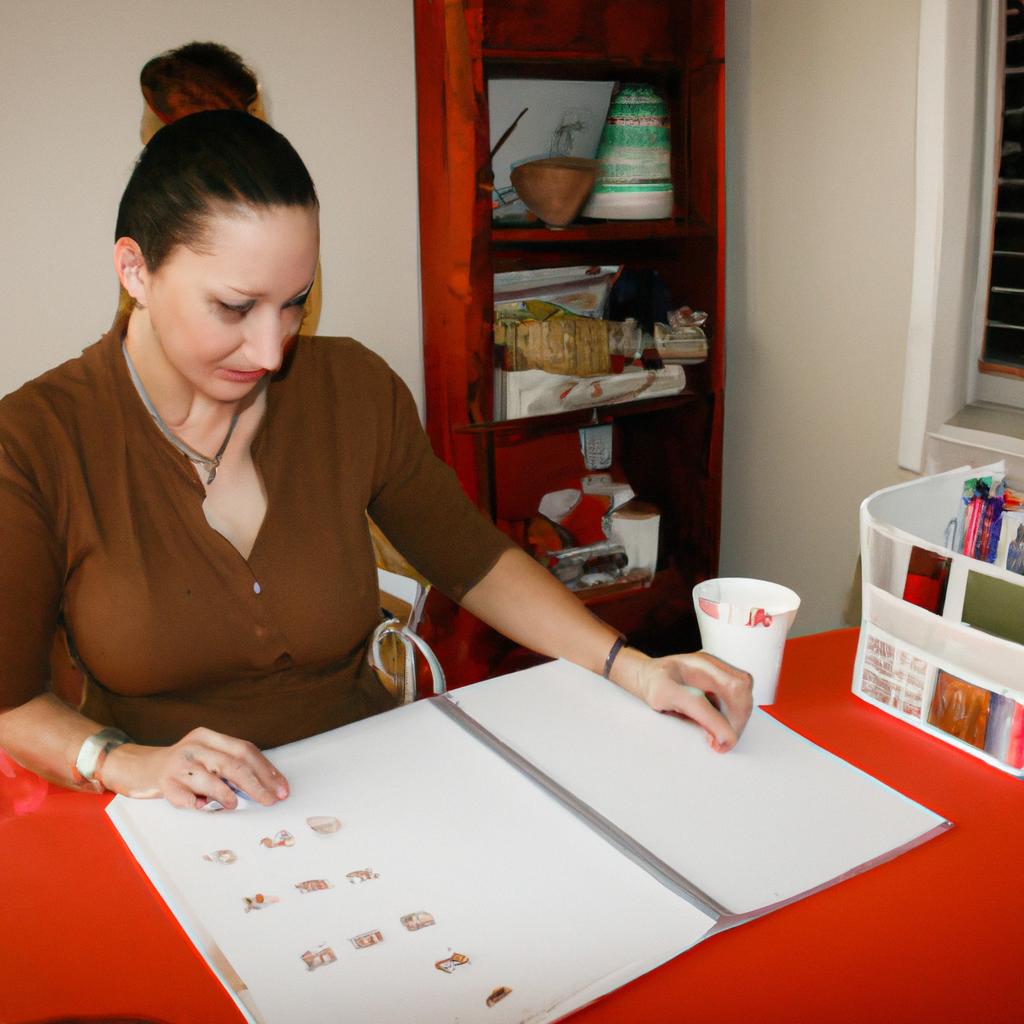In the context of a Montessori school, the role of the teacher is crucial in guiding students towards self-directed learning through a method known as guided discovery. This approach emphasizes hands-on exploration and problem-solving, allowing students to construct their knowledge at their own pace. By fostering an environment that encourages curiosity and independence, the Montessori teacher plays a vital role in facilitating children’s growth and development.
Consider the case of Emily, a five-year-old student enrolled in a Montessori classroom. During a math lesson on addition, her teacher presents her with manipulative materials such as beads or blocks to represent numbers. Rather than directly instructing Emily on how to perform addition, the teacher guides her by asking open-ended questions like “What happens when we combine two groups of three?” Through this process, Emily engages in active experimentation and discovers mathematical concepts independently. The Montessori teacher acts as both an observer and facilitator, providing guidance when needed while giving children ample space for exploration and self-discovery.
Guided discovery enables students to actively participate in their learning journey and develop essential skills such as critical thinking, problem-solving, and autonomy. In this article, we will explore the multifaceted role of the Montessori teacher within this framework, including their responsibilities in creating a prepared environment, fostering a sense of community and respect among students, and individualizing instruction to meet each child’s unique needs.
Creating a prepared environment
Creating a prepared environment is a fundamental aspect of the Montessori method, as it sets the stage for children’s independent learning and exploration. In this section, we will explore how the Montessori teacher plays a crucial role in designing and maintaining such an environment.
To illustrate this point, let us consider a hypothetical scenario. Imagine a Montessori classroom with various activity areas, each carefully arranged with materials that promote hands-on learning and foster independence. The practical life area includes tasks like pouring water or tying shoelaces, allowing children to develop fine motor skills and gain a sense of accomplishment through completing everyday tasks. In the sensorial area, they can explore different textures, shapes, sizes, and colors—an opportunity for them to refine their senses.
One essential element of creating a prepared environment is organization. Materials are meticulously arranged on low shelves within easy reach of the children. This arrangement empowers them to choose activities independently and reinforces their decision-making skills. Furthermore, clear labels accompany each material to aid children in returning items to their designated places after use—a practice that cultivates responsibility.
Aesthetic appeal also contributes significantly to the prepared environment’s ambiance and effectiveness. Colors are chosen intentionally—soft pastels create a calm atmosphere conducive to concentration while stimulating curiosity. Natural lighting streams into the room through large windows where plants thrive, bringing nature indoors; these elements combine to provide an inviting space that nurtures creativity and exploration.
The emotional impact of creating such an environment cannot be understated. When entering a well-prepared classroom filled with engaging materials neatly displayed amidst an aesthetically pleasing setting, both children and adults alike feel inspired and motivated to learn together. It fosters feelings of excitement and curiosity about what lies ahead—the anticipation of new discoveries waiting to be made.
In summary, creating a prepared environment involves careful attention to detail regarding organization, aesthetics, accessibility, and overall design principles—all intended to facilitate independent learning experiences for students. The next section will explore how Montessori teachers observe and assess student needs within this environment, ensuring individualized guidance and support throughout the learning journey.
Observing and assessing student needs
Transitioning from the previous section on creating a prepared environment, the role of the Montessori teacher extends beyond designing the physical space. In order to facilitate optimal learning experiences for students in a Montessori school, teachers engage in guided discovery and actively observe and assess student needs.
One example of guided discovery is when a Montessori teacher introduces a new material to their students. Let’s consider a hypothetical scenario where the teacher presents a puzzle activity that requires problem-solving skills. Rather than providing step-by-step instructions, the teacher encourages children to explore and experiment with different approaches independently or collaboratively. This approach fosters creativity, critical thinking, and self-directed learning.
When engaging in guided discovery, Montessori teachers uphold several principles:
- Encouraging autonomy: Teachers provide opportunities for students to make decisions and take ownership of their learning journey.
- Cultivating curiosity: By sparking interest through open-ended questions or intriguing challenges, educators motivate students to seek knowledge proactively.
- Promoting collaboration: Group activities foster social interaction, communication skills development, and cooperative problem-solving abilities among peers.
- Emphasizing reflection: After completing an activity or task, teachers encourage students to reflect on their experience and share insights gained during the process.
To further support these principles effectively, Montessori teachers utilize observation as an essential tool. Through careful observation, they gain valuable insights into each student’s unique strengths, interests, and areas requiring additional guidance. These observations enable teachers to tailor instruction according to individualized needs while promoting inclusive practices within the classroom.
In summary, by embracing guided discovery techniques and employing astute observational skills, Montessori teachers create dynamic learning environments that stimulate curiosity and cultivate independent exploration. The next section will delve into how these dedicated educators provide individualized guidance and support based on their observations of student needs without imposing rigid structures.
Providing individualized guidance and support
Building upon the foundation of observing and assessing student needs, the Montessori teacher utilizes this valuable information to provide individualized guidance and support in a Montessori school setting.
Paragraph 1:
To effectively meet the unique learning requirements of each student, the Montessori teacher engages in ongoing observation and assessment. For instance, let us consider a hypothetical case study where a five-year-old child named Emily is struggling with concentration during independent work time. Through careful observation, the teacher notices that Emily becomes easily distracted by external stimuli such as noise or movement within the classroom environment. By objectively assessing these observations, it becomes evident that Emily may benefit from additional support to develop her concentration skills.
Paragraph 2:
In order to address students’ individual needs like Emily’s, Montessori teachers employ various strategies tailored specifically for each learner. This approach allows them to promote optimal development across all areas – cognitive, social, emotional, and physical. The following bullet point list highlights some key techniques utilized by Montessori educators:
- Creating an organized and stimulating classroom environment conducive to exploration
- Implementing hands-on materials and activities that encourage active engagement
- Providing opportunities for peer collaboration and cooperative learning
- Offering regular one-on-one sessions to monitor progress and offer personalized guidance
Paragraph 3:
Furthermore, Montessori teachers utilize tools such as structured assessments and anecdotal records to track each student’s growth over time accurately. These records serve not only as evidence of progress but also act as important references when planning future lessons or interventions. To illustrate this practice visually, refer to the table below demonstrating how different types of assessments can be used effectively in guiding instruction:
| Assessment Type | Purpose | Example |
|---|---|---|
| Observations | Identify strengths/weaknesses | Noticing patterns in behavior |
| Work samples | Measure progress | Portfolio of completed work |
| Checklists | Track completion of tasks | Completion record for math activities |
| Formal assessments | Evaluate mastery levels | Standardized test scores |
By effectively observing and assessing student needs, Montessori teachers lay the groundwork for promoting independence and self-directed learning in their students.
Promoting independence and self-directed learning
Providing individualized guidance and support in a Montessori school is just one aspect of the role of a Montessori teacher. Another important responsibility involves promoting independence and self-directed learning among students. By creating an environment that fosters exploration and discovery, teachers encourage children to take ownership of their education.
For example, imagine a five-year-old student named Emily who is working on a math activity involving counting beads. The Montessori teacher observes Emily struggling with certain concepts, but instead of intervening immediately, the teacher allows her to explore different approaches independently. This approach provides Emily with the opportunity to problem-solve and develop critical thinking skills at her own pace.
To promote independence and self-directed learning effectively, Montessori teachers employ various strategies:
- Encouraging choice: Teachers offer students a range of activities tailored to their developmental needs and interests. This choice empowers children to select tasks they are passionate about, fostering enthusiasm for learning.
- Establishing clear expectations: Teachers provide guidelines and boundaries within which students can freely explore. These expectations help create structure while allowing room for creativity and personal expression.
- Offering support when needed: While encouraging independent exploration, teachers maintain a watchful eye and step in only when necessary. They assess each child’s progress individually, offering targeted assistance or guidance as required.
- Cultivating intrinsic motivation: Rather than relying solely on extrinsic rewards like grades or prizes, Montessori teachers focus on nurturing each child’s internal drive to learn. By recognizing effort rather than outcome alone, they foster a genuine love for knowledge-seeking.
The table below summarizes key techniques used by Montessori teachers to promote independence and self-directed learning:
| Techniques | Benefits |
|---|---|
| Choice | Empowers students |
| Clear expectations | Provides structure |
| Targeted support | Individualized instruction |
| Intrinsic motivation | Fosters a love for learning |
By promoting independence and self-directed learning, Montessori teachers empower students to become active participants in their education. This approach not only enhances academic skills but also cultivates essential life skills such as problem-solving, decision-making, and self-motivation.
Transitioning into the subsequent section about “Facilitating hands-on experiences and exploration,” Montessori educators further engage students by providing opportunities for interactive learning. Through these experiential activities, children can deepen their understanding of various subjects while actively engaging with the world around them.
Facilitating hands-on experiences and exploration
Section: Fostering Independence through Guided Discovery
Transitioning from the previous section on promoting independence and self-directed learning, the role of the Montessori teacher extends further to include facilitating guided discovery in a Montessori school. By utilizing this approach, teachers can create an environment that encourages students to explore and learn independently while providing them with necessary guidance when needed.
For instance, let us consider a hypothetical case study involving a four-year-old child named Emily. Emily enters her Montessori classroom filled with various materials for practical life activities. The Montessori teacher introduces Emily to a tray containing pouring exercises, demonstrating how to carefully pour water into different containers without spilling it. Empowered by her curiosity, Emily begins exploring the activity at her own pace, pouring water back and forth between two jugs. When facing challenges or encountering obstacles, the Montessori teacher steps in gently, offering support and redirecting her attention towards problem-solving strategies.
Guided discovery is achieved through several key techniques employed by Montessori teachers:
- Observation: Teachers closely observe their students’ interests, strengths, and areas requiring additional assistance.
- Scaffolding: They provide just enough support to help children achieve tasks independently while gradually reducing their involvement over time.
- Questioning: Teachers pose open-ended questions that stimulate critical thinking skills and encourage students to reflect upon their experiences.
- Encouragement: Positive reinforcement is given throughout the process of guided discovery to motivate students and build confidence in their abilities.
Through these methods, children develop crucial skills such as problem-solving, decision-making, and self-assessment within a supportive environment where they are encouraged to take risks and make mistakes as part of their learning journey.
The next section will delve deeper into another vital aspect of the Montessori teaching method – fostering a love for learning among young learners. By embracing this approach wholeheartedly, Montessori teachers can nurture a lifelong passion for education and exploration in their students, empowering them to become enthusiastic learners beyond the confines of the classroom.
Fostering a love for learning
Transitioning from the previous section, where we explored the importance of facilitating hands-on experiences and exploration in a Montessori school, we now delve into another crucial aspect of the role of the Montessori teacher: fostering a love for learning. By instilling curiosity and passion within their students, teachers help create an environment that encourages lifelong learning and personal growth.
To illustrate this point, let us consider the case of Sarah, a five-year-old student at XYZ Montessori School. During her time in the classroom, Sarah showed a particular interest in plants and insects. Sensing her enthusiasm, her Montessori teacher designed various activities centered around these subjects. Through guided discovery, Sarah was able to explore different types of plants and observe insect behavior firsthand. This personalized approach not only deepened Sarah’s understanding but also ignited a genuine love for these topics.
The Montessori teacher employs several strategies to foster a love for learning:
- Cultivating intrinsic motivation: Rather than relying on external rewards or punishments, teachers focus on harnessing each child’s internal drive to learn. They encourage self-directed exploration and provide opportunities for independent decision-making.
- Nurturing individual interests: Recognizing that children have unique passions and talents, Montessori teachers tailor their lessons to suit each student’s needs. By incorporating topics that resonate with learners’ interests, they ignite enthusiasm and inspire further inquiry.
- Encouraging collaboration: Collaboration plays a vital role in creating an engaging learning environment. Teachers facilitate group projects and discussions where students can share ideas, exchange knowledge, and learn from one another’s perspectives.
- Celebrating achievements: Recognizing accomplishments helps reinforce positive associations with learning. Whether it is through verbal praise or small tokens like certificates or stickers, acknowledging effort fosters self-confidence and motivates continued engagement.
| Benefits of Fostering Love for Learning |
|---|
| 1. Increased motivation and engagement |
| 3. Boosted self-esteem and confidence |
This approach to teaching not only nurtures a love for learning but also empowers children to become lifelong learners who are curious, adaptable, and eager to explore the world around them.
In summary, by fostering a love for learning through personalized experiences, Montessori teachers empower students like Sarah to develop intrinsic motivation and curiosity. Through strategies such as cultivating individual interests, encouraging collaboration, and celebrating achievements, these educators create an environment that supports continuous growth and instills a passion for acquiring knowledge. By valuing each child’s unique journey, Montessori teachers play a pivotal role in shaping students’ attitudes towards education and their own personal development.

